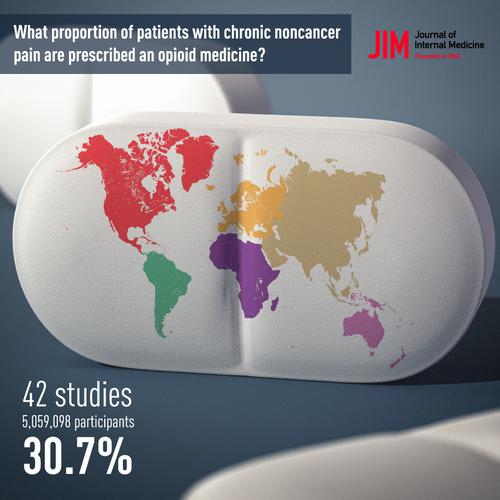当前位置:
X-MOL 学术
›
J. Intern. Med.
›
论文详情
Our official English website, www.x-mol.net, welcomes your
feedback! (Note: you will need to create a separate account there.)
What proportion of patients with chronic noncancer pain are prescribed an opioid medicine? Systematic review and meta-regression of observational studies.
Journal of Internal Medicine ( IF 9.0 ) Pub Date : 2020-02-25 , DOI: 10.1111/joim.13026 S Mathieson 1, 2 , G Wertheimer 3 , C G Maher 1, 2 , C-W Christine Lin 1, 2 , A J McLachlan 4 , R Buchbinder 5, 6 , S-A Pearson 7 , M Underwood 8, 9
Journal of Internal Medicine ( IF 9.0 ) Pub Date : 2020-02-25 , DOI: 10.1111/joim.13026 S Mathieson 1, 2 , G Wertheimer 3 , C G Maher 1, 2 , C-W Christine Lin 1, 2 , A J McLachlan 4 , R Buchbinder 5, 6 , S-A Pearson 7 , M Underwood 8, 9
Affiliation

|
Guidelines now discourage opioid analgesics for chronic noncancer pain because the benefits frequently do not outweigh the harms. We aimed to determine the proportion of patients with chronic noncancer pain who are prescribed an opioid, the types prescribed and factors associated with prescribing. Database searches were conducted from inception to 29 October 2018 without language restrictions. We included observational studies of adults with chronic noncancer pain measuring opioid prescribing. Opioids were categorized as weak (e.g. codeine) or strong (e.g. oxycodone). Study quality was assessed using a risk of bias tool designed for observational studies measuring prevalence. Individual study results were pooled using a random-effects model. Meta-regression investigated study-level factors associated with prescribing (e.g. sampling year, geographic region as per World Health Organization). The overall evidence quality was assessed using Grading of Recommendations Assessment, Development and Evaluation criteria. Of the 42 studies (5,059,098 participants) identified, the majority (n = 28) were from the United States of America. Eleven studies were at low risk of bias. The pooled estimate of the proportion of patients with chronic noncancer pain prescribed opioids was 30.7% (95% CI 28.7% to 32.7%, n = 42 studies, moderate-quality evidence). Strong opioids were more frequently prescribed than weak (18.4% (95% CI 16.0-21.0%, n = 15 studies, low-quality evidence), versus 8.5% (95% CI 7.2-9.9%, n = 15 studies, low-quality evidence)). Meta-regression determined that opioid prescribing was associated with year of sampling (more prescribing in recent years) (P = 0.014) and not geographic region (P = 0.056). Opioid prescribing for patients with chronic noncancer pain is common and has increased over time.
中文翻译:

哪些比例的慢性非癌性疼痛患者开有阿片类药物?观察性研究的系统评价和元回归。
现在的指导方针不鼓励使用阿片类镇痛药治疗慢性非癌性疼痛,因为其益处通常不会超过其危害。我们旨在确定服用阿片类药物的慢性非癌性疼痛患者的比例,处方类型以及与处方有关的因素。从开始到2018年10月29日进行数据库搜索,没有语言限制。我们纳入了对患有阿片类药物处方的慢性非癌性疼痛成年人的观察性研究。阿片类药物分为弱类(例如可待因)或强类(例如羟考酮)。使用专为观察研究测量患病率而设计的偏倚风险工具评估研究质量。使用随机效应模型汇总单个研究结果。荟萃回归调查了与处方相关的研究水平因素(例如抽样年份,根据世界卫生组织确定的地理区域)。总体证据质量使用“建议评估,发展和评估等级”标准进行评估。在所确定的42项研究(5,059,098名参与者)中,大多数(n = 28)来自美利坚合众国。十一项研究的偏倚风险较低。患有慢性非癌性疼痛处方阿片类药物的患者的总估计为30.7%(95%CI为28.7%至32.7%,n = 42个研究,中等质量的证据)。强阿片类药物的处方频率高于弱阿片类药物(18.4%(95%CI 16.0-21.0%,n = 15研究,低质量证据)),而8.5%(95%CI 7.2-9.9%,n = 15研究,低-质量证据))。荟萃回归确定阿片类药物处方与抽样年份有关(近年来处方较多)(P = 0。014)而不是地理区域(P = 0.056)。阿片类药物通常用于慢性非癌性疼痛患者,并随时间增加。
更新日期:2020-02-25
中文翻译:

哪些比例的慢性非癌性疼痛患者开有阿片类药物?观察性研究的系统评价和元回归。
现在的指导方针不鼓励使用阿片类镇痛药治疗慢性非癌性疼痛,因为其益处通常不会超过其危害。我们旨在确定服用阿片类药物的慢性非癌性疼痛患者的比例,处方类型以及与处方有关的因素。从开始到2018年10月29日进行数据库搜索,没有语言限制。我们纳入了对患有阿片类药物处方的慢性非癌性疼痛成年人的观察性研究。阿片类药物分为弱类(例如可待因)或强类(例如羟考酮)。使用专为观察研究测量患病率而设计的偏倚风险工具评估研究质量。使用随机效应模型汇总单个研究结果。荟萃回归调查了与处方相关的研究水平因素(例如抽样年份,根据世界卫生组织确定的地理区域)。总体证据质量使用“建议评估,发展和评估等级”标准进行评估。在所确定的42项研究(5,059,098名参与者)中,大多数(n = 28)来自美利坚合众国。十一项研究的偏倚风险较低。患有慢性非癌性疼痛处方阿片类药物的患者的总估计为30.7%(95%CI为28.7%至32.7%,n = 42个研究,中等质量的证据)。强阿片类药物的处方频率高于弱阿片类药物(18.4%(95%CI 16.0-21.0%,n = 15研究,低质量证据)),而8.5%(95%CI 7.2-9.9%,n = 15研究,低-质量证据))。荟萃回归确定阿片类药物处方与抽样年份有关(近年来处方较多)(P = 0。014)而不是地理区域(P = 0.056)。阿片类药物通常用于慢性非癌性疼痛患者,并随时间增加。











































 京公网安备 11010802027423号
京公网安备 11010802027423号